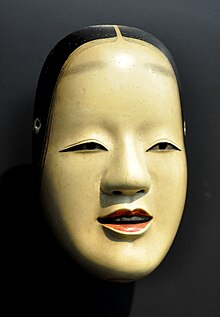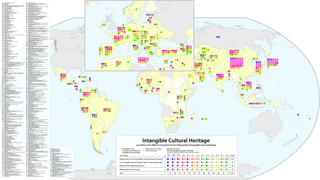Definition

The Convention for the Safeguarding of the Intangible Cultural Heritage [4] defines the intangible cultural heritage as the practices, representations, expressions, as well as the knowledge and skills (including instruments, objects, artifacts, cultural spaces), that communities, groups, and, in some cases, individuals, recognize as part of their cultural heritage. It is sometimes called living cultural heritage, and is manifested in the following domains, among others: [5]
- Oral traditions and expressions, including language as a vehicle of the intangible cultural heritage;
- Performing arts;
- Social practices, rituals and festive events;
- Knowledge and practices concerning nature and the universe;
- Traditional craftsmanship

Cultural heritage in general consists of the products and processes of a culture that are preserved and passed on through the generations. [6] Some of that heritage takes the form of cultural property, formed by tangible artefacts such as buildings or works of art. Many parts of culture, however are intangible, including song, music, dance, drama, skills, cuisine, crafts and festivals. These are forms of culture that can be recorded but cannot be touched or stored in physical form, like in a museum, but only experienced through a vehicle giving expression to it. Such cultural vehicles are called "Human Treasures" by the UN. The protection of languages, as the largest and most important intangible cultural heritage, should also be mentioned in this context. According to Karl von Habsburg, President of Blue Shield International, protection of languages is important in the age of identity wars, because language in particular can become a target for attack as a symbolic cultural asset. [7]

According to the 2003 Convention for the Safeguarding of the Intangible Cultural Heritage, the intangible cultural heritage (ICH) – or living heritage – is the mainspring of humanity's cultural diversity and its maintenance a guarantee for continuing creativity. It is defined as follows:
Intangible Cultural Heritage means the practices, representations, expressions, knowledge, skills – as well as the instruments, objects, artifacts and cultural spaces associated therewith – that communities, groups and, in some cases, individuals recognize as part of their cultural heritage. This intangible cultural heritage, transmitted from generation to generation, is constantly recreated by communities and groups in response to their environment, their interaction with nature and their history, and provides them with a sense of identity and continuity, thus promoting respect for cultural diversity and human creativity. For the purposes of this Convention, consideration will be given solely to such intangible cultural heritage as is compatible with existing international human rights instruments, as well as with the requirements of mutual respect among communities, groups and individuals, and of sustainable development.
Oral history
Intangible cultural heritage is slightly different from the discipline of oral history, the recording, preservation and interpretation of historical information (specifically, oral tradition), based on the personal experiences and opinions of the speaker. ICH attempts to preserve cultural heritage 'with' the people or community by protecting the processes that allow traditions and shared knowledge to be passed on while oral history seeks to collect and preserve historical information obtained from individuals and groups.[ citation needed ]
Food heritage
With sustainable development gaining momentum as a priority of UNESCO heritage policies, an increasing number of food-related nominations are being submitted for inscription on the lists of the convention for the safeguarding of the intangible cultural heritage. [9] The Mediterranean diet, [10] the traditional Mexican cuisine and the Japanese dietary culture of washoku are just some examples of this booming phenomenon.[ citation needed ]
Dance heritage

The UNESCO lists of intangible cultural heritage also include a variety of dance genres, often associated with singing, music and celebrations, from all over the world. The lists include: celebratory and ritual dances such as Ma'di bowl lyre music and Sebiba dance from Algeria and dance from Uganda and Kalbelia folk songs and dances of Rajasthan from India, and social dances such as Cuban rumba. Also, some dances are localized and practiced mainly in their country of origin, such as Sankirtana, a performing art that includes drumming and singing, from India.[ citation needed ]
Other dance forms, [11] however, even if they are officially recognized as heritage from their country of origin, are practiced and enjoyed all over the world. For example, flamenco from Spain and tango, from Argentina and Uruguay, have an international dimension. Dance is a complex phenomenon, which involves culture, traditions, the use of human bodies, artefacts (such as costumes and props), as well as a specific use of music, space and sometimes light. As a result, a lot of tangible and intangible elements [12] are combined within dance, making it a challenging but interesting type of heritage to safeguard.[ citation needed ]
Digital heritage
Digital heritage is a representation of heritage in the digital realm and is a sub-category of Intangible Cultural Heritage. [13] It refers primarily to the use of digital media in the service of preserving cultural or natural heritage. [14] [15] [16]
Sports heritage










